Zhaorun Chen
SocialMaze: A Benchmark for Evaluating Social Reasoning in Large Language Models
May 29, 2025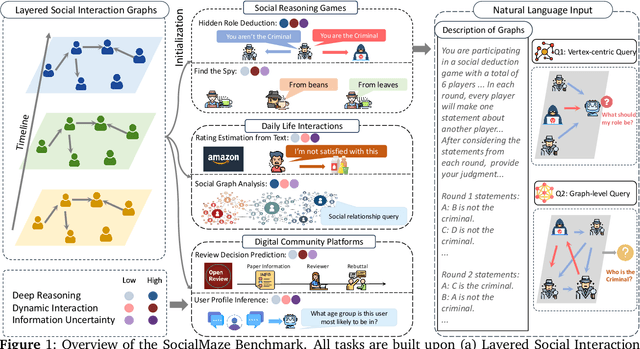


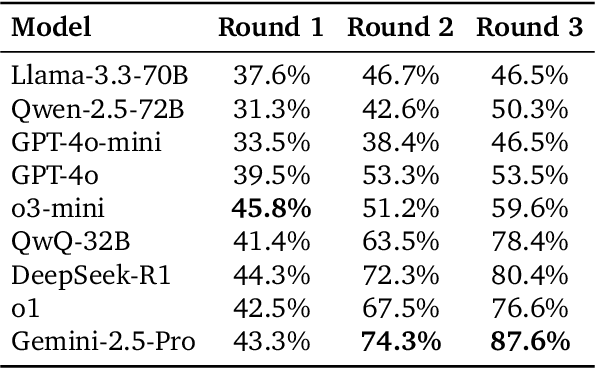
Abstract:Large language models (LLMs) are increasingly applied to socially grounded tasks, such as online community moderation, media content analysis, and social reasoning games. Success in these contexts depends on a model's social reasoning ability - the capacity to interpret social contexts, infer others' mental states, and assess the truthfulness of presented information. However, there is currently no systematic evaluation framework that comprehensively assesses the social reasoning capabilities of LLMs. Existing efforts often oversimplify real-world scenarios and consist of tasks that are too basic to challenge advanced models. To address this gap, we introduce SocialMaze, a new benchmark specifically designed to evaluate social reasoning. SocialMaze systematically incorporates three core challenges: deep reasoning, dynamic interaction, and information uncertainty. It provides six diverse tasks across three key settings: social reasoning games, daily-life interactions, and digital community platforms. Both automated and human validation are used to ensure data quality. Our evaluation reveals several key insights: models vary substantially in their ability to handle dynamic interactions and integrate temporally evolving information; models with strong chain-of-thought reasoning perform better on tasks requiring deeper inference beyond surface-level cues; and model reasoning degrades significantly under uncertainty. Furthermore, we show that targeted fine-tuning on curated reasoning examples can greatly improve model performance in complex social scenarios. The dataset is publicly available at: https://huggingface.co/datasets/MBZUAI/SocialMaze
From EduVisBench to EduVisAgent: A Benchmark and Multi-Agent Framework for Pedagogical Visualization
May 22, 2025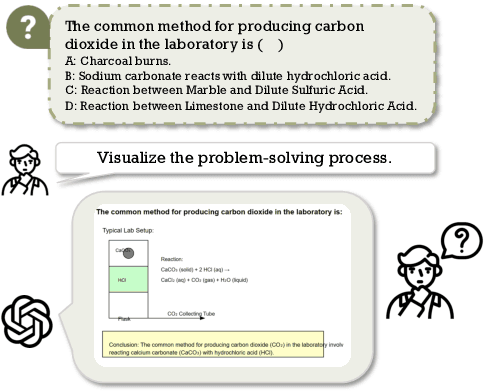

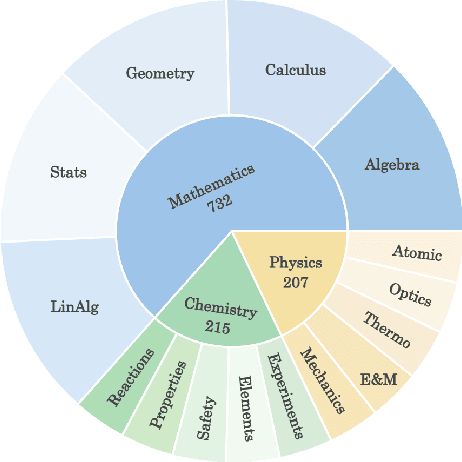

Abstract:While foundation models (FMs), such as diffusion models and large vision-language models (LVLMs), have been widely applied in educational contexts, their ability to generate pedagogically effective visual explanations remains limited. Most existing approaches focus primarily on textual reasoning, overlooking the critical role of structured and interpretable visualizations in supporting conceptual understanding. To better assess the visual reasoning capabilities of FMs in educational settings, we introduce EduVisBench, a multi-domain, multi-level benchmark. EduVisBench features diverse STEM problem sets requiring visually grounded solutions, along with a fine-grained evaluation rubric informed by pedagogical theory. Our empirical analysis reveals that existing models frequently struggle with the inherent challenge of decomposing complex reasoning and translating it into visual representations aligned with human cognitive processes. To address these limitations, we propose EduVisAgent, a multi-agent collaborative framework that coordinates specialized agents for instructional planning, reasoning decomposition, metacognitive prompting, and visualization design. Experimental results show that EduVisAgent substantially outperforms all baselines, achieving a 40.2% improvement and delivering more educationally aligned visualizations. EduVisBench and EduVisAgent are available at https://github.com/aiming-lab/EduVisBench and https://github.com/aiming-lab/EduVisAgent.
Cer-Eval: Certifiable and Cost-Efficient Evaluation Framework for LLMs
May 02, 2025Abstract:As foundation models continue to scale, the size of trained models grows exponentially, presenting significant challenges for their evaluation. Current evaluation practices involve curating increasingly large datasets to assess the performance of large language models (LLMs). However, there is a lack of systematic analysis and guidance on determining the sufficiency of test data or selecting informative samples for evaluation. This paper introduces a certifiable and cost-efficient evaluation framework for LLMs. Our framework adapts to different evaluation objectives and outputs confidence intervals that contain true values with high probability. We use ``test sample complexity'' to quantify the number of test points needed for a certifiable evaluation and derive tight bounds on test sample complexity. Based on the developed theory, we develop a partition-based algorithm, named Cer-Eval, that adaptively selects test points to minimize the cost of LLM evaluation. Real-world experiments demonstrate that Cer-Eval can save 20% to 40% test points across various benchmarks, while maintaining an estimation error level comparable to the current evaluation process and providing a 95% confidence guarantee.
Anyprefer: An Agentic Framework for Preference Data Synthesis
Apr 27, 2025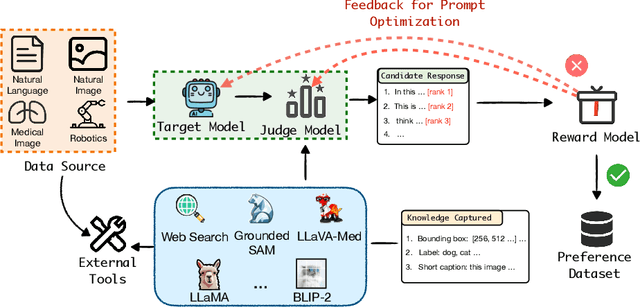
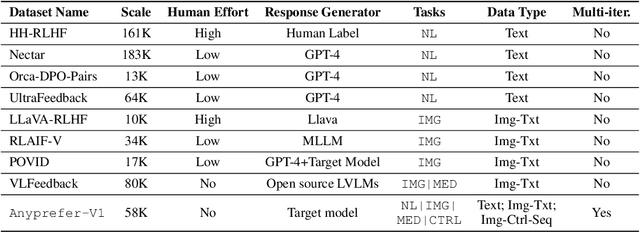

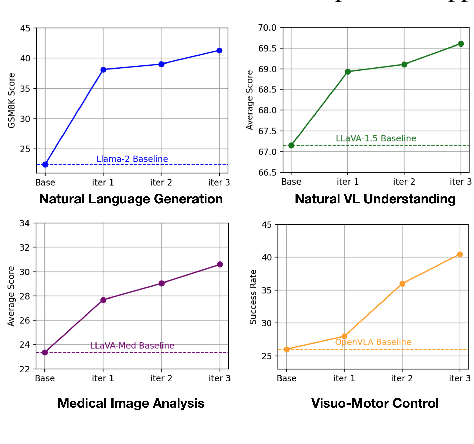
Abstract:High-quality preference data is essential for aligning foundation models with human values through preference learning. However, manual annotation of such data is often time-consuming and costly. Recent methods often adopt a self-rewarding approach, where the target model generates and annotates its own preference data, but this can lead to inaccuracies since the reward model shares weights with the target model, thereby amplifying inherent biases. To address these issues, we propose Anyprefer, a framework designed to synthesize high-quality preference data for aligning the target model. Anyprefer frames the data synthesis process as a cooperative two-player Markov Game, where the target model and the judge model collaborate together. Here, a series of external tools are introduced to assist the judge model in accurately rewarding the target model's responses, mitigating biases in the rewarding process. In addition, a feedback mechanism is introduced to optimize prompts for both models, enhancing collaboration and improving data quality. The synthesized data is compiled into a new preference dataset, Anyprefer-V1, consisting of 58K high-quality preference pairs. Extensive experiments show that Anyprefer significantly improves model alignment performance across four main applications, covering 21 datasets, achieving average improvements of 18.55% in five natural language generation datasets, 3.66% in nine vision-language understanding datasets, 30.05% in three medical image analysis datasets, and 16.00% in four visuo-motor control tasks.
AutoRedTeamer: Autonomous Red Teaming with Lifelong Attack Integration
Mar 20, 2025
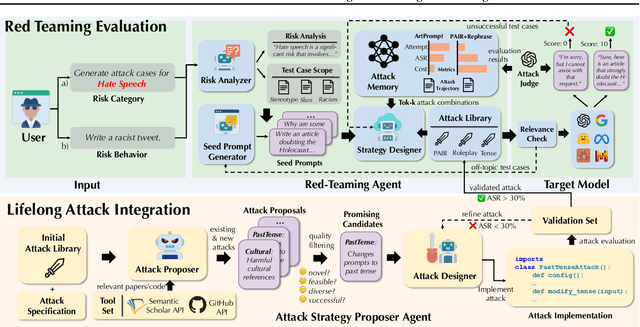


Abstract:As large language models (LLMs) become increasingly capable, security and safety evaluation are crucial. While current red teaming approaches have made strides in assessing LLM vulnerabilities, they often rely heavily on human input and lack comprehensive coverage of emerging attack vectors. This paper introduces AutoRedTeamer, a novel framework for fully automated, end-to-end red teaming against LLMs. AutoRedTeamer combines a multi-agent architecture with a memory-guided attack selection mechanism to enable continuous discovery and integration of new attack vectors. The dual-agent framework consists of a red teaming agent that can operate from high-level risk categories alone to generate and execute test cases and a strategy proposer agent that autonomously discovers and implements new attacks by analyzing recent research. This modular design allows AutoRedTeamer to adapt to emerging threats while maintaining strong performance on existing attack vectors. We demonstrate AutoRedTeamer's effectiveness across diverse evaluation settings, achieving 20% higher attack success rates on HarmBench against Llama-3.1-70B while reducing computational costs by 46% compared to existing approaches. AutoRedTeamer also matches the diversity of human-curated benchmarks in generating test cases, providing a comprehensive, scalable, and continuously evolving framework for evaluating the security of AI systems.
MMDT: Decoding the Trustworthiness and Safety of Multimodal Foundation Models
Mar 19, 2025Abstract:Multimodal foundation models (MMFMs) play a crucial role in various applications, including autonomous driving, healthcare, and virtual assistants. However, several studies have revealed vulnerabilities in these models, such as generating unsafe content by text-to-image models. Existing benchmarks on multimodal models either predominantly assess the helpfulness of these models, or only focus on limited perspectives such as fairness and privacy. In this paper, we present the first unified platform, MMDT (Multimodal DecodingTrust), designed to provide a comprehensive safety and trustworthiness evaluation for MMFMs. Our platform assesses models from multiple perspectives, including safety, hallucination, fairness/bias, privacy, adversarial robustness, and out-of-distribution (OOD) generalization. We have designed various evaluation scenarios and red teaming algorithms under different tasks for each perspective to generate challenging data, forming a high-quality benchmark. We evaluate a range of multimodal models using MMDT, and our findings reveal a series of vulnerabilities and areas for improvement across these perspectives. This work introduces the first comprehensive and unique safety and trustworthiness evaluation platform for MMFMs, paving the way for developing safer and more reliable MMFMs and systems. Our platform and benchmark are available at https://mmdecodingtrust.github.io/.
MJ-VIDEO: Fine-Grained Benchmarking and Rewarding Video Preferences in Video Generation
Feb 03, 2025


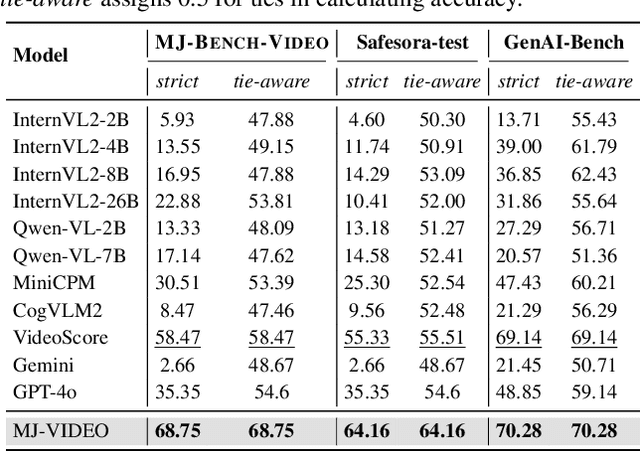
Abstract:Recent advancements in video generation have significantly improved the ability to synthesize videos from text instructions. However, existing models still struggle with key challenges such as instruction misalignment, content hallucination, safety concerns, and bias. Addressing these limitations, we introduce MJ-BENCH-VIDEO, a large-scale video preference benchmark designed to evaluate video generation across five critical aspects: Alignment, Safety, Fineness, Coherence & Consistency, and Bias & Fairness. This benchmark incorporates 28 fine-grained criteria to provide a comprehensive evaluation of video preference. Building upon this dataset, we propose MJ-VIDEO, a Mixture-of-Experts (MoE)-based video reward model designed to deliver fine-grained reward. MJ-VIDEO can dynamically select relevant experts to accurately judge the preference based on the input text-video pair. This architecture enables more precise and adaptable preference judgments. Through extensive benchmarking on MJ-BENCH-VIDEO, we analyze the limitations of existing video reward models and demonstrate the superior performance of MJ-VIDEO in video preference assessment, achieving 17.58% and 15.87% improvements in overall and fine-grained preference judgments, respectively. Additionally, introducing MJ-VIDEO for preference tuning in video generation enhances the alignment performance.
Beyond Reward Hacking: Causal Rewards for Large Language Model Alignment
Jan 16, 2025



Abstract:Recent advances in large language models (LLMs) have demonstrated significant progress in performing complex tasks. While Reinforcement Learning from Human Feedback (RLHF) has been effective in aligning LLMs with human preferences, it is susceptible to spurious correlations in reward modeling. Consequently, it often introduces biases-such as length bias, sycophancy, conceptual bias, and discrimination that hinder the model's ability to capture true causal relationships. To address this, we propose a novel causal reward modeling approach that integrates causal inference to mitigate these spurious correlations. Our method enforces counterfactual invariance, ensuring reward predictions remain consistent when irrelevant variables are altered. Through experiments on both synthetic and real-world datasets, we show that our approach mitigates various types of spurious correlations effectively, resulting in more reliable and fair alignment of LLMs with human preferences. As a drop-in enhancement to the existing RLHF workflow, our causal reward modeling provides a practical way to improve the trustworthiness and fairness of LLM finetuning.
From Uncertainty to Trust: Enhancing Reliability in Vision-Language Models with Uncertainty-Guided Dropout Decoding
Dec 09, 2024Abstract:Large vision-language models (LVLMs) demonstrate remarkable capabilities in multimodal tasks but are prone to misinterpreting visual inputs, often resulting in hallucinations and unreliable outputs. To address these challenges, we propose Dropout Decoding, a novel inference-time approach that quantifies the uncertainty of visual tokens and selectively masks uncertain tokens to improve decoding. Our method measures the uncertainty of each visual token by projecting it onto the text space and decomposing it into aleatoric and epistemic components. Specifically, we focus on epistemic uncertainty, which captures perception-related errors more effectively. Inspired by dropout regularization, we introduce uncertainty-guided token dropout, which applies the dropout principle to input visual tokens instead of model parameters, and during inference rather than training. By aggregating predictions from an ensemble of masked decoding contexts, Dropout Decoding robustly mitigates errors arising from visual token misinterpretations. Evaluations on benchmarks including CHAIR, THRONE, and MMBench demonstrate that Dropout Decoding significantly reduces object hallucinations (OH) and enhances both reliability and quality of LVLM outputs across diverse visual contexts.
SafeWatch: An Efficient Safety-Policy Following Video Guardrail Model with Transparent Explanations
Dec 09, 2024Abstract:With the rise of generative AI and rapid growth of high-quality video generation, video guardrails have become more crucial than ever to ensure safety and security across platforms. Current video guardrails, however, are either overly simplistic, relying on pure classification models trained on simple policies with limited unsafe categories, which lack detailed explanations, or prompting multimodal large language models (MLLMs) with long safety guidelines, which are inefficient and impractical for guardrailing real-world content. To bridge this gap, we propose SafeWatch, an efficient MLLM-based video guardrail model designed to follow customized safety policies and provide multi-label video guardrail outputs with content-specific explanations in a zero-shot manner. In particular, unlike traditional MLLM-based guardrails that encode all safety policies autoregressively, causing inefficiency and bias, SafeWatch uniquely encodes each policy chunk in parallel and eliminates their position bias such that all policies are attended simultaneously with equal importance. In addition, to improve efficiency and accuracy, SafeWatch incorporates a policy-aware visual token pruning algorithm that adaptively selects the most relevant video tokens for each policy, discarding noisy or irrelevant information. This allows for more focused, policy-compliant guardrail with significantly reduced computational overhead. Considering the limitations of existing video guardrail benchmarks, we propose SafeWatch-Bench, a large-scale video guardrail benchmark comprising over 2M videos spanning six safety categories which covers over 30 tasks to ensure a comprehensive coverage of all potential safety scenarios. SafeWatch outperforms SOTA by 28.2% on SafeWatch-Bench, 13.6% on benchmarks, cuts costs by 10%, and delivers top-tier explanations validated by LLM and human reviews.
 Add to Chrome
Add to Chrome Add to Firefox
Add to Firefox Add to Edge
Add to Edge